Possible effects of the introduction of average speed measurement on road safety. Part 2
Abstract
This article is the continuation of the article titled Traffic Analysis of Expressway Sections Using the Average Speed Measurement Method, Part 1, published in KTSZ in April 2020. Now the author tries to estimate the impact of the introduction of average speed measurement on traffic safety based on the available domestic accident statistics and the international results related to the introduction of speed control. The topic focuses on accident prevention and on the identification of potential impacts. The topicality is given by the significant rate of speeding incidents on motorways [12], published in the author's previous article. The estimate was based on the domestic personal injury road traffic accident data in 2018.
References
Elvik, R.: The Power model of the relationsip between speed and road safety, TOI report 1034/2009, 2009
Holló Péter, Zsigmond Olivér (2005). Emelt közúti sebességhatárok közlekedésbiztonsági hatásvizsgálata idősorok elemzésével. KÖZLEKEDÉSTUDOMÁNYI SZEMLE 55 : 3 pp. 90-95. 6 p. (2005)
Központi Statisztikai Hivatal, adatszolgáltatás 2019.
Mocsári Tibor (2013). Az átlagsebességbalesetszám összefüggés vizsgálata hazai adatok alapján. Útügyi Lapok 1. szám (2013) ISSN: 2064-0919
Módszertani útmutató egyes közlekedési projektek költség-haszon elemzéséhez (2016). Nemzeti Fejlesztési Minisztérium
Nilsson, G.: Traffic safety dimensions and Power model to describe the effect of speed on safety, doctoril thesis, Lund, 2004
Országos közutak 2018. évre vonatkozó keresztmetszeti forgalma (2019). Magyar Közút Nonprofit Zrt. Budapest, 2019.
Soole, D., Fleiter, J., Watson, B., 2012. Pointto-Point Speed Enforcement (AP-R415- 12). Austroads, Sydney.
Soole, D.W., Watson, B.C., & Fleiter, J.F. (2013). Effects of average speed enforcement on speed compliance and crashes: A review of the literature. Accident Analysis and Prevention, 54, 46-56.
Wijnen, W., Weijermars, W., Vanden Berghe, W., Schoeters, A., Bauer, R., Carnis, L., Elvik, R., Theofilatos, A., Filtness, A., Reed, S., Perez, C., and Martensen, H. (2017). Crash cost estimates for European countries, Deliverable 3.2 of the H2020 project SafetyCube
Sipos, T., 2019. Könnyű sérülés statisztikai veszteségértékének meghatározása, KTI kutatási témajelentés 2019.
Holló Péter és Sipos Tibor (2019): http://kozlekedesbiztonsag.kti.hu/kozut ibaleseti-vesztesegek-aktualizalasa/
Sándor Zsolt és Monostori Ákos (2020) Gyorsforgalmi útszakaszok forgalmi elemzése az átlagsebesség-mérés módszerével. 1. rész, Közlekedéstudományi Szemle 70 : 2. pp. 54-67. 14 p. (2020) DOI: https://doi.org/10.24228/KTSZ.2020.2.5
Articles published electronically are open access (OJS), freely available online and can be downloaded. Authors of articles are not charged any publication or publishing costs (APC). Users have the right to read, download, copy, print, and search the articles, or share the full text with a link.
Authors must declare that their submission has not been previously published in another journal, that financial support has been acknowledged, and that the list of references is complete and accurate, including specification of URLs and DOIs (if available). When submitting a draft article, each author approves the submitted version. Authors guarantee that the article is their original work. Authors are required to participate in the peer review process, follow the advice of reviewers, meet the prescribed deadlines, and, if any, withdraw the submission or correct errors.
All submitted articles are subject to peer review, where the editors request an independent evaluation from at least one expert, ensuring that the reviewer(s) have no conflicts of interest with the authors. The final decision is made by the Editor-in-Chief, who takes into account the evaluations and the suggestions of the editors. The editors and reviewers treat the submission confidentially.
The publisher and editors are committed to maintaining high ethical standards and to preventing publications that involve research misconduct. They follow the COPE guidelines on such ethical issues.
The authors retain copyright and grant the journal the right of first publication under the Creative Commons License (https://creativecommons.org/licenses/by-nc-nd/4.0), which allows others to share the work, while acknowledging the authorship of the work and the first publication in the journal.
The journal archives all published articles, and the journal's owner, the Hungarian Society of Transportation Sciences, will continue to operate the database even if the journal ceases to be published.















